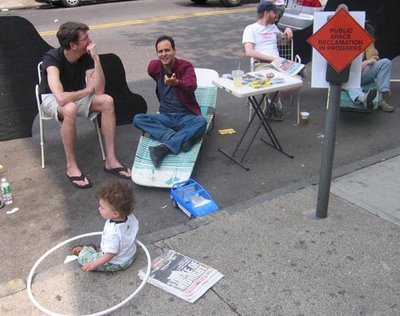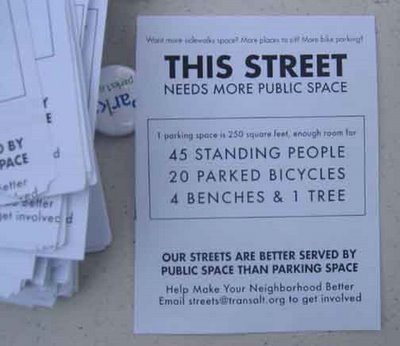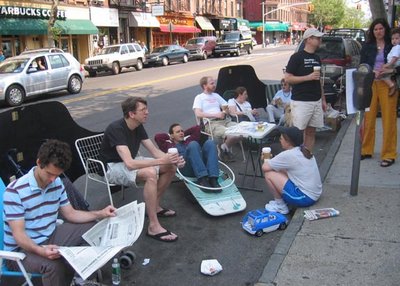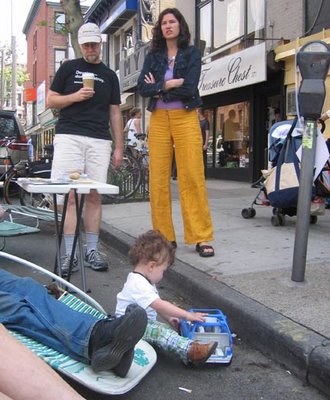Car-Free Central Park Action Update
Below is an update from Ken Coughlin, Chair of Transportation Alternative's Car-Free Central Park Committee, to campaign supporters.
------
Things have been happening, as I'm sure many of you are aware. The details and our analysis are below, but before getting to that, I have a personal message for all supporters of a car-free Central Park. If you read no further, please read this, and forward it on:
The next few weeks will decide whether Central Park will be car-free this summer, and, by extension, how quickly we will win a park that is permanently free of traffic. Even though you and thousands of other park users favor a car-free park, persuading elected officials to act against the interests of even a handful of drivers can be surprisingly difficult. YOU are the only force that will persuade them to do this. They have heard that 102,000 people signed a petition in support of a car-free park. But claims of signatures on pieces of paper are one thing; real voters who contact them are another.
As they decide how to vote, the Council members will be looking closely for evidence of continued strong support. If instead they sense apathy or indifference on this issue, they are unlikely to stick their necks out and vote against the interests of motorists.
Toward the end of this week, Transportation Alternatives will be sending out an action alert. There may also be follow-up calls for action. To win a car-free park, we all must respond. I know that you have heard this message before, but a successful advocacy campaign absolutely depends on persistent effort. No one can say whether we will prevail in the next few weeks, but I can guarantee you that we will fail unless we continue to demonstrate to elected officials that thousands of New Yorkers want Central Park to be car free, at least for this summer.
NOW THE NEWS:
As you may know, City Council members Gale Brewer and John Liu have introduced a bill, Intro. 276, mandating a car-free summer in Central Park from June 24 to September 24, 2006, as well as car-free afternoons in Prospect Park during the same period. On May 8, the day before the Council Transportation Committee's scheduled hearing on the bill, Mayor Bloomberg announced a six-month pilot plan to ban traffic from portions of Central Park's loop road that are already little used by cars. As of Monday June 5, 2006, vehicles will no longer be allowed on Central Park's East Drive north of 72nd Street in the morning or anywhere (apparently) on the West Drive in the afternoon. (In addition, Prospect Park's West Drive will be closed to traffic in the mornings.)
The mayor's announcement was clearly an effort to drain support from the Council bill by giving car-free supporters something while maintaining the loop road as a traffic artery. Whether this strategy will succeed remains to be seen. While any reduction in car usage is welcome, most of the loop road will continue to be flooded with cars during prime recreational hours. Worse, recreational users who may believe they are exercising in a totally car-free park will suddenly encounter traffic, perhaps with disastrous consequences. The administration is now boasting that the loop road is free of traffic "75 percent of the time." We don't know how they arrived at this figure. Between prime recreational hours of 7 am and 7 pm, the loop road is entirely free of traffic exactly 0 percent of the time. Considering that the park is officially closed from 1 am until 6 am, even under the new rules the loop will be entirely free of traffic for only seven hours -- from 7 pm to 1 am and from 6 am to 7 am (assuming the entrances are opened and closed on time).
The Council hearing went forward as planned the following day. The Transportation Committee, chaired by Liu, first heard from Transportation Commissioner Iris Weinshall. Although Weinshall had stood alongside the mayor the day before and said that "people come to New York City's parks to get away from the hustle and bustle of urban life," at the hearing she declared that Central Park's loop road was an "essential traffic artery" and that its closing would cause "significant" disruption. Pressed by Council member Daniel Garodnick for a definition of "significant," Weinshall and First Deputy Commissioner Michael Primeggia offered only more vague portents of traffic tie-ups.
They were followed by a panel of three independent traffic experts who believe that closing the Central Park loop road to traffic will lead to an overall reduction in traffic on city streets. Under questioning from Garodnick, consultant Bruce Schaller said that "shrinkage" -- the percentage of cars now using the park that would effectively disappear from the street grid if Central Park were closed -- could reach 100 percent. Schaller said that the Department of Transportation's assumption of 15 percent shrinkage was too pessimistic.
Other witnesses speaking in favor of the bill included Columbia University professor Patrick L. Kinney, an expert on the human health effects of air pollution. Noting that fine particles from car exhaust can lodge deep in the lungs and cause lung cancer, heart disease and asthma, Kinney said "moving traffic off of the park loop roads will significantly reduce health risks for people using the park, especially those exercising along the loop roads."
Since this was just a hearing, the committee's stance on the bill was hard to read. We know that Liu and Brewer are 100 percent behind Intro. 276. At a press conference prior to the hearing, both spoke strongly in favor of it, as did Brooklyn Council member Bill de Blasio and Manhattan Borough President Scott Stringer, whose latest newsletter to Manhattan residents twice mentions his support of a car-free Central Park. We believe Intro. 276 also has the support of East Side Council members Garodnick, Jessica Lappin and Melissa Mark Viverito. The big question mark is Council Speaker Christine Quinn, who may hold the key to not only the bill's passage but its passing with enough votes to overcome an almost certain mayoral veto. Quinn has not yet made her position known.
It is likely that the Transportation Committee will vote on Intro. 276 in late May, and, assuming it passes, a full Council vote will come shortly thereafter.
Again, prior to these votes the Speaker and other Council members will be paying close attention to the level of popular support the bill has. We need to show them that New Yorkers want nothing less than a safe and pollution-free Central Park loop road this summer.
Ken Coughlin,
Chair
Transportation Alternatives' Car-Free Central Park Committee






